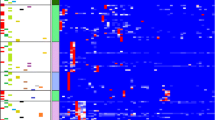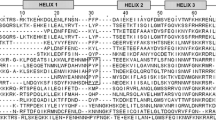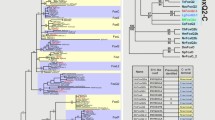Abstract
In the former part of the review the principal available data aboutHox genes, their molecular organisation and their expression in vertebrate embryos, with particular emphasis for mammals, are briefly summarized.
In the latter part we analysed the expression of four mouse homeobox genes related to twoDrosophila genes expressed in the developing head of the fly: Emx1 and Emx2, related toems, and Otx1 and Otx2, related tootd.
Similar content being viewed by others
References
Acampora, D., M. D'Esposito, A. Faiella, M. Pannese, E. Migliaccio, F. Morelli, A. Stornaiuolo, V. Nigro, A. Simeone & E. Boncinelli, 1989. The human HOX gene family. Nucleic Acids Res. 17: 10385–10402.
Akam, M., 1989. Hox and HOM: homologous gene clusters in insects and vertebrates. Cell 57: 347–349.
Andrews, P. W., 1984. Retinoic acid induces neural differentiation of a cloned human embryonal carcinoma cell linein vitro. Dev. Biol. 103: 285–293.
Balling, R., G. Mutter, P. Gruss & M. Kessel, 1989. Craniofacial abnormalities induced by ectopic expression of the homeobox gene Hox 1.1 in transgenic mice. Cell 58: 337–347.
Bastian, H. & P. Gruss, 1990. A murine even-skipped homologue. Evx1, is expressed during early embryogenesis and neurogenesis in a biphasic manner. EMBO J. 9: 1839–1852.
Bieberich, C. J., M. F. Utset, A. Awgulewitsch & F. H. Ruddle, 1990. Evidence for positive and negative regulation of the Hox-3.1 gene. Proc. Natl. Acad. USA 87: 8462–8466.
Blumberg, B., C. V. E. Wright, E. M. DeRobertis & K. W. Y. Cho, 1991. Organizer-specific homebox genes inXenopus laevis embryos. Science 253: 194–196.
Boncinelli, E., A. Simeone, D. Acampora & F. Mavilio, 1991. HOX gene activation by retinoic acid. Trends in Genetics 7: 329–334.
Brockes, J. P., 1989. Retinoids, homeobox genes and limb morphogenesis. Neuron 2: 1285–1294.
Chisaka, O. & M. Capecchi, 1991. Regionally restricted developmental defects resulting from targetted disruption of the mouse homeobox gene Hox1.5. Nature 350: 473–479.
Cho, K. W. Y., J. Goetz, C. V. Wright, A. Fritz, J. Hardwicke & E. M. DeRobertis, 1988. Differential utilization of the same open reading frame in a Xenopus homeobox gene encodes two related proteins sharing the same DNA-binding specificity. EMBO J. 7: 2139–2149.
Cohen, S. & C. Jurgens, 1991.Drosophila head-lines. Trends Genet. 7: 267–272.
Dalton, D., R. Chadwick & W. McGinnis, 1989. Expression and embryonic function of empty spiracles: aDrosophila homeobox gene with two patterning functions on the anterior-posterior axis of the embryo. Genes Dev. 3: 1940–1956.
Dekker, E. J., M. Pannese, E. Houtzager, E. Boncinelli & A. Durston, 1992. Colinearity in theXenopus. 1. Hox-2 complex. Mech. of Dev. 40: 3–12.
Dekker, E. J., M. Pannese, E. Houtzager, A. Timmermans, E. Boncinelli & A. Durston, 1992.Xenopus Hox-2 genes are expressed sequentially after the onset of gastrulation and are differentially inducible by retinoic acid. Development, 1992 Supplement: 195–202.
De Robertis, E., M. G. Oliver & C. V. E. Wright, 1989. Determination of axial polarity in the vertebrate embryo: homeodomain proteins and homeogenetic induction. Cell 57: 189–191.
Deschamps, J. & F. Meijlink, 1992. Mammalian homeobox genes in normal development and neoplasia. Critical Reviews in Oncogenesis 3: 117–173.
D'Esposito, M., F. Morelli, D. Acampora, E. Migliaccio, A. Simeone & E. Boncinelli, 1991. EVX2, a human homeobox gene homologous to the even-skipped segmentation gene, is localized at the 5′ end of HOX4 locus on chromosome 2. Genomics 10: 43–50.
Dollé, P., J. C. Izpisua-Belmonte, H. Falkenstein, A. Renucci & D. Duboule, 1989. Coordinate expression of the murine Hox-5 complex homeobox containing genes during limb bud pattern formation. Nature 342: 767–772.
Dollé, P. & D. Duboule, 1989. Two genes members of the murine HOX-5 complex show regional and cell-type specific expression in developing limbs and gonads. EMBO J. 8: 1507.
Dressler, G. R. & P. Gruss, 1989. Anterior boundaries of the Hox gene expression in mesoderm-derived structures correlate with the linear order along the chromosome. Differentiation 41: 193–201.
Driever, W. & C. Nüsslein-Volhard, 1988. The bicoid protein determinates position in theDrosophila embryo in a concentration dependent manner. Cell 54: 95–104.
Duboule, D. & P. Dollé, 1989. The structural and functional organization of the murine Hox gene family resembles that ofDrosophila homeotic genes. EMBO J. 8: 1497–1505.
Durston, A. J., J. P. M. Timmermans, W. J. Hage, H. F. J. Hendriks, N. J. de Vries, M. Heideveld & P. D. Niewkoop, 1989. Retinoic acid causes an anterior posterior transformation in the developing nervous system. Nature 340: 140–144.
Faiella, A., M. D'Esposito, M. Rambaldi, D. Acampora, S. Balsofiore, A. Stornauiolo, A. Mallamaci, E. Migliaccio, M. Gulisano, A. Simeone & E. Boncinelli, 1991. Isolation and mapping of EVX1, a human homeobox gene homologous to even-skipped, localized at the 5′ end of HOX1 locus on chromosome 7. Nucleic Acids Res. 19: 6541–6545.
Figdor, M. & C. Stern, 1993. Segmental organization of embryonic diencephalon. Nature 363: 630–634.
Frohman, M. A., M. Boyle & G. M. Martin, 1990. Isolation of the mouse Hox-2.9 gene; analysis of embryonic expression suggests that positional information along the anterior-posterior axis is specified by mesoderm. Development 110: 589–607.
Finkelstein, R. & N. Perrimon, 1991. The molecular genetics of head development inDrosophila melanogaster. Development 112: 899–912.
Gaunt, S. J., 1987. Homeobox gene Hox-1.5 expression in mouse embryos: earliest detection byin situ hybridisation is during gastrulation. Development 101: 51–60.
Gaunt, S. J., 1988. Mouse homeobox gene transcripts occupy different but overlapping domains in embryonic germ layers and organs: a comparison of Hox-3.1 and Hox-1.5. Development 103: 135–144.
Gaunt, S. J. & P. B. Singh, 1990. Homeogene expression patterns and chromosomal imprinting. Trends Genet. 6: 208–212.
Gehring, W. P., 1987. Homeoboxes in the study of development. Science 236: 1245–1252.
Giampaolo, A., D. Acampora, V. Zappavigna, M. Pannese, M. D'Esposito, A. Carè, A. Faiella, A. Stornaiuolo, G. Russo, A. Simeone, E. Boncinelli & C. Peschle, 1989. Differential expression of human HOX2 genes along the anterior-posterior axis in embryonic central nervous system. Differentiation 40: 191–197.
Graham, A., N. Papalopulu & R. Krumlauf, 1989. The murine andDrosophila homeobox gene complexes have common features of organization and expression. Cell 57: 367–378.
Graham, A., M. Maden & R. Krumlauf, 1991. The murine Hox-2 genes display dynamic dorsoventral patterns of expression during central nervous system development. Development 112: 255–264.
Holland, P. W. H. & B. L. M. Hogan, 1988. Expression of homeobox genes during mouse development: a review. Genes Dev. 2: 773–782.
Hunt, P., M. Gulisano, M. Cook, M. H. Sham, A. Faiella, D. Wilkinson, E. Boncinelli & R. Krumlauf, 1991a. A distinct code for the branchial region of the vertebrate head. Nature 353: 861–864.
Hunt, P., J. Whiting, S. Nonchev, M. H. Sham, H. Marshall, A. Graham, M. Cook, R. Alleman, P. W. J. Rigby, M. Gulisano, A. Faiella, E. Boncinelli & R. Krumlauf, 1991b. The branchial code and its implications for gene regulation, patterning of the nervous system and head evolution. Development, Supplement 2: 63–77.
Izpisua-Belmonte, J. C., C. Tickle, P. Dollé, L. Wolpert & D. Duboule, 1991. Expression of homebox Hox-4 genes and the specification of position in chick wing development. Nature 350: 585–589.
Kessel, M. & P. Gruss, 1990. Murine developmental control genes. Science 249: 374–379.
Kessel, M. & P. Gruss, 1991. Homeotic transformations of murine prevertebrae and concomitant alteration of Hox codes induced by retinoic acid. Cell 67: 89–104.
Kuhlenbeck, H., 1973. Morphological Pattern of the Vertebrate Neuroaxis, pp. 471–668 in The Central Nervous System of Vertebrates Edited by S. Karger, Basel.
Lawson, K. A., J. J. Meneses & R. A. Pedersen, 1991. Clonal analysis of epiblast fate during germ layer formation in the mouse embryo. Development 113: 891–911.
Le Mouellic, H., Y. Lallemand & P. Brulet, 1992. Homeosis in the mouse induced by a null mutation in the Hox-3.1 gene. Cell 69: 251–264.
Levine, M. & T. Hoey, 1988. Homeobox proteins as sequencespecific transcription factors. Cell 55: 537–540.
Lewis, E. B., 1978. A gene complex controlling segmentation inDrosophila. Nature 276: 565–570.
Lufkin, T., A. Dierich, M. LeMeur, M. Mark & P. Chambon, 1991. Disruption of the Hox-1.6 homeobox gene results in defects in a region corresponding to its rostral domain of expression. Cell 66: 1105–1119.
Luskin, M. B., A. L. Pearlman & J. R. Sanes, 1988. Cell lineage in the cerebral cortex of the mouse studiedin vivo andin vitro with a recombinant retrovirus. Neuron 1: 635–647.
Magli, M. C., P. Barba, A. Celetti, G. De Vita, C. Cillo & E. Boncinelli, 1991. Coordinate regulation of HOX genes in human hematopoietic cells. Proc. Natl. Acad. USA 88: 6348–6352.
Martinez, S., M. Wassef & R. M. Alvarado-Mallard, 1991. Induction of a Mesencephalic phenotype in the 2-day-old chick prosencephalon is preceded by the early expression of the homeobox gene en. Neuron 6: 971–981.
Mavilio, F., A. Simeone, A. Giampaolo, A. Faiella, V. Zappavigna, D. Acampora, G. Poiana, G. Russo, C. Peschle & E. Boncinelli, 1986. Differential and stage-related expression in embryonic tissues of a new human homeobox gene. Nature 324: 664–668.
McGinnis, W., M. S. Levine, E. Hafen, A. Kuroiwa & W. J. Gehring, 1984. A conserved DNA sequence in homeotic genes of theDrosophila Antennapedia and Bithorax complexes. Nature 308: 428–433.
McGinnis, W. & R. Krumlauf, 1992. Homeobox genes and axial patterning. Cell 68: 283–302.
Noden, D., 1988. Interactions and fates of avian craniofacial mesenchyme. Development, 103 Supplement: 121–140.
Noji, S., T. Nohno, E. Koyama, K. Muto, K. Ohyama, Y. Aoki, K. Tamura, K. Ohsugi, H. Ide, S. Taniguchi & T. Saito, 1991. Retinoic acid induces polarizing activity but is unlikely to be a morphogen in the chick limb bud. Nature 350: 83–86.
Oliver, G., C. V. E. Wright, J. Hardwicke & E. M. De Robertis, 1990. Differential antero-posterior expression of two proteins encoded by a homeobox gene inXenopus and mouse embryos. EMBO J. 7: 3199–3209.
Puelles, L., J. A. Amat & M. Martinez-de-la-Torre, 1987. Segmentrelated, mosaic neurogenetic pattern in the forebrain and mesencephalon of early chick embryos: I. Topography of AchE-positive neuroblasts up to stage HH18. J. Comp. Neurol. 266: 247–268.
Puschel, A. W., R. Balling & P. Gruss, 1990. Position-specific activity of the Hox-1.1 promoter in transgenic mice. Development 108: 435–442.
Sakay, Y., 1987. Neurulation in the mouse. I. The ontogenesis of neural segments and the determination of topographical regions in a central nervous system. Anat. Rec. 218: 450–457.
Scott, M. P. & A. J. Weiner, 1984. Structural relationships among genes that control development: sequence homology between the Antennapedia, Ultrabithorax and fushi tarazu loci ofDrosophila. Proc. Natl. Acad. Sci. 81: 4115–4119.
Scott, M. P., J. W. Tamkun & G. W. Hartzell, 1989. The structure and the function of the homeodomain. Biochim. Biophys. Acta 989: 25–48.
Scott, M. P., 1992. Vertebrate homeobox gene nomenclature. Cell 71: 551–553.
Shashikant, C. S., M. F. Utset, S. M. Violette, T. L. Wise, M. Einat, J. W. Pendleton, K. S. Schugart & F. H. Ruddle, 1991. Homeobox genes in mouse development. Crit. Rev. Eukaryotic Gene Expression 1: 207.
Simeone, A., M. Pannese, D. Acampora, M. D'Esposito & E. Boncinelli, 1988. At least three human homeoboxes on chromosome 12 belong to the same transcription unit. Nucleic Acids Res. 16: 5379–5390.
Simeone, A., D. Acampora, L. Arcioni, P. W. Andrews, E. Boncinelli & F. Mavilio, 1990. Sequential activation of HOX3 homeobox genes by retinoic acid in human embryonal carcinoma cells. Nature 346: 763–766.
Simeone, A., D. Acampora, V. Nigro, A. Faiella, M. D'Esposito, A. Stornaiuolo, F. Mavilio & E. Boncinelli, 1991. Differential regulation by retinoic acid of the homeobox genes of the four Hox loci in human embryonal carcinoma cells. Mech. of Dev. 33: 215–228.
Simeone, A., M. Gulisano, D. Acampora, A. Stornaiuolo, M. Rambaldi & E. Boncinelli, 1992a. Two vertebrate homeobox genes related to theDrosophila empty spiracles gene are expressed in the embryonic cerebral cortex. EMBO J. 11: 2541–2550.
Simeone, A., D. Acampora, M. Gulisano, A. Stornaiuolo & E. Boncinelli, 1992b. Nested expression domains of four homeobox genes in developing rostral brain. Nature 358: 687–690.
Simeone, A., D. Acampora, A. Mallamaci, A. Stornaiuolo, M. R. D'Apice, V. Nigro & E. Boncinelli, 1993. A vertebrate gene related to orthodenticle contains a homeodomain of the bicoid class and demarcates anterior neuroectoderm in the gastrulating mouse embryo. EMBO J. 12: 2735–2747.
Stornaiuolo, A., D. Acampora, M. Pannese, M. D'Esposito, F. Morelli, E. Migliaccio, M. Rambaldi, A. Faiella, V. Nigro, A. Simeone & E. Boncinelli, 1990. Human HOX genes are differentially activated by retinoic acid in embryonal carcinoma cells according to their position within the four loci. Cell Differentiation and Development 31: 119–127.
Stuart, J. J., S. J. Brown, R. B. Beemann & R. E. Denell, 1991. A deficiency of the homeotic complex of the beetleTribolium. Nature 350: 72–74.
Tam, P. P. L., 1989. Regionalisation of the mouse embryonic ectoderm: allocation of prospective extodermal tissues during gastrulation. Development 107: 55–67.
Tessier-Lavigne, M., 1992. Axon guidance by molecular gradients. Current Opinion In NeuroBiology 2: 60–65.
Thaller, C. & G. Eichele, 1987. Identification and spatial distribution of retinoids in the developing chick limb bud. Nature 327: 625–628.
Tickle, C., B. Alberts, L. Wolpert & J. Lee, 1982. Local application of retinoic acid to the limb bud mimics the action of the polarizing region. Nature 296: 564–566.
Waneck, N., D. M. Gardiner, K. Muneoka & S. V. Bryant, 1991. Conversion by retinoic acid of anterior cells into ZPA cells in the chick limb bud. Nature 350: 81–83.
Wieschaus, E., N. Perrimon & R. Finkelstein, 1992. Orthodenticle activity is required for development of medial structures in the larval and adult epidermis ofDrosophila. Development 115: 801–811.
Wright, C. V. E., K. W. Y. Cho, G. Oliver & E. M. De Robertis, 1989. Vertebrate homeodomain protein: families of region-specific transcription factors. Trends Biochem. Sci. 14: 52–56.




